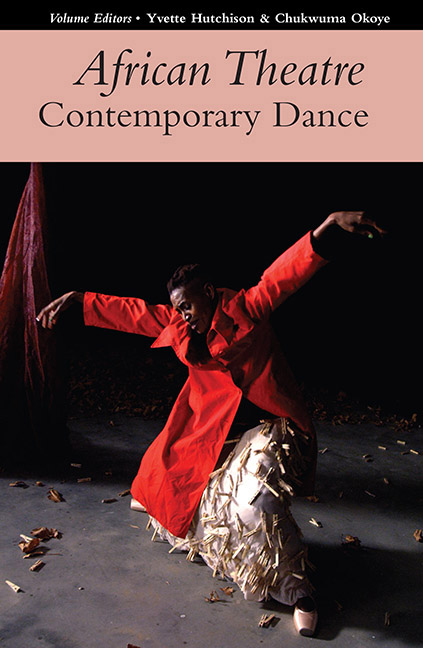Book contents
- Frontmatter
- Contents
- Notes on Contributors
- Introduction
- I Dance
- James Mweu & Kunja Dance Theatre Contemporary dance as African cultural production
- Looking Behind the Mirror Challenging representationalism in contemporary dance in postcolonial African contexts
- Decolonising the Stage Reflecting on Mamela Nyamza in a Canadian-hosted South African performance festival
- Unmuting South African Citizenship through Integrated/Disability Dance
- From Television to the Streets The rise & rise of dance-based advertising in Nigeria
- Dance Photo Essay ‘Untitled’: FOD Gang's environmental activism
- II Open Section
- Book Reviews
From Television to the Streets The rise & rise of dance-based advertising in Nigeria
from I - Dance
Published online by Cambridge University Press: 26 July 2019
- Frontmatter
- Contents
- Notes on Contributors
- Introduction
- I Dance
- James Mweu & Kunja Dance Theatre Contemporary dance as African cultural production
- Looking Behind the Mirror Challenging representationalism in contemporary dance in postcolonial African contexts
- Decolonising the Stage Reflecting on Mamela Nyamza in a Canadian-hosted South African performance festival
- Unmuting South African Citizenship through Integrated/Disability Dance
- From Television to the Streets The rise & rise of dance-based advertising in Nigeria
- Dance Photo Essay ‘Untitled’: FOD Gang's environmental activism
- II Open Section
- Book Reviews
Summary
You can tell the ideals of a nation by its advertisements.
Norman Douglas
The purpose of this research is to analyse the trend of dance-based advertising in Nigeria. The research appraises the nature and features of dance in two street/outdoor promotional and television commercials respectively. The study argues communication as a salient function of dance, borrowing insight from interpretive and affective communication theories for an analysis of the use of dance in specific adverts. This research adopts descriptive, analytical and deductive research methods to analyse how and why dance-based adverts in Nigeria have become a popular feature in street/outdoor promotional and television adverts. Drawing on its entertainment value, as well as its narrative and expressive attributes, dance has become an important factor in advertising.
In Nigeria, dance is a vital art form, permeating every aspect of life, and is one of the vibrant and expressive features of Nigerian culture and creative arts. It is a living art which performs multiple functions, including worship, entertainment, therapy, a means of cultural identification and, in recent times, advertising as well. The advertising world is a highly competitive one, therefore, advertisers are forever devising ways to make products more appealing to consumers. Being an expressive and affective global language, dance can communicate potentially indelible images in the minds of its audiences. Thus, dance has become one of the creative tools employed by advertisers for their trade.
Several studies have explored the relationship between advertising and the performing arts. Travassos (2016) treated the issue of dance space in contemporary audio-visual advertising, while Walter and Altamimi (2011) examined dance in advertising vis-à-vis cultural meaning, and its influence on consumption and culture. Anjum et al. (2012) investigated the impact of celebrity-endorsed adverts on consumers, and Allan (2006) considered the effects of popular music in advertising on attention and memory. However, in spite of the existing research in these areas, there is a dearth of literature on the forms and structure of choreography in dance-based adverts made in Africa. Information is especially lacking on the form and nature of dance as utilised in street/ outdoor promotional and television adverts. This research, therefore, examines the dance forms and choreographic principles deployed in these adverts.
- Type
- Chapter
- Information
- African Theatre: Contemporary Dance , pp. 90 - 112Publisher: Boydell & BrewerPrint publication year: 2018



